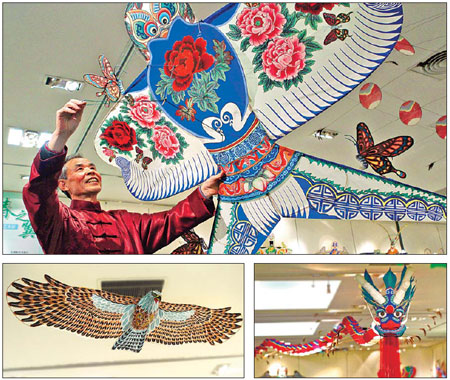Flying kites is a popular pastime for many Beijingers. But for kite-maker Hao Deli, kites are more than just a fun outdoor activity, they are art.
 |
|
Clockwise: Hao Deli with a swallow kite he made for the kite exhibition; Hao's dragon kite has a total length of 100 meters; Eagles are a favorite theme. |
"Flying kites is just a way to exercise in other countries, where simple colors are matched to form the pattern of a kite," he told METRO. "In China, however, kites represent people's moods, so the handiwork and decoration are more complicated and beautiful."
Constructed from paper, silk and bamboo, Chinese kites can be categorized by their images, such as dragons, swallows, eagles and the legendary Monkey King.
Of all the images commonly seen on traditional kites, the most representative one for Beijing, and the one best mastered by Hao, is the dragon.
The dragon kite is unique because it has a 3D head featuring a dragon, a lion or a centipede with a long tail formed by many small round-shaped kites that can stretch for 100 meters. Before the Qing Dynasty (1644-1911), only the emperor was allowed to fly a dragon kite.
Of all the types of kites, the dragon is the hardest to make, said Hao, because it requires all the small round-shaped kites on the tail, which can reach 200 in number, to be identical; and even the length of string connecting each one has to be the same.
Hao said he used to fly a dragon kite in the 1980s that needed the help of 16 other people. The tail of the dragon went into the air first, lifting the 5-kilogram head - and often the man holding the head with it.
Although he is an amateur, at the age of 67, Hao has been making kites for more than 30 years.
He became interested in making kites at a young age and has spent most of his life in Glass Street, where the city's kite-making craftsmen used to gather. All his spare time was spent on kite making even after he got a job designing precision instruments.
"Though the kites made by craftsmen are delicate, it is still easy compared with what I handled at work, which was all micro-sized," said Hao.
The kite-making process consists of four steps: binding, pasting, painting and flying. But even before the binding there is a lot of preparation work required, starting with picking out the right bamboo.
The best bamboo should be at least 3 years old, with a diameter greater than 10 centimeters and a green-yellow color. Hao said the water content of such bamboo provides the best elasticity.
The bamboo is then split by hand into different sizes, and the pieces dried in the air for at least a year, before being heated over a fire.
"A good kite can keep its balance in the air," said Hao. "To achieve this, the thickness and curvature of the bamboo splints used on both wings of the kite have to be identical."
Images of animals or historical figures are painted on paper or silk before being pasted to the bamboo frame. But in the case of a dragon's head, the painting is done after pasting.
The last step is the flying.
"No matter how beautiful or delicate the kite is, if you can't fly it, it is a painting rather than a kite," he said.
Originating in the Qin Dynasty (221-206 BC), kites were originally used for military purposes, such as measuring distance. It was not until the Qing Dynasty that kite flying became a popular pastime.
Nowadays people often fly kites during Qingming, the Tomb-Sweeping Day, when traditionally the string of the kite is cut so that it flies free, taking with it any bad luck.
(China Daily March 31, 2011)